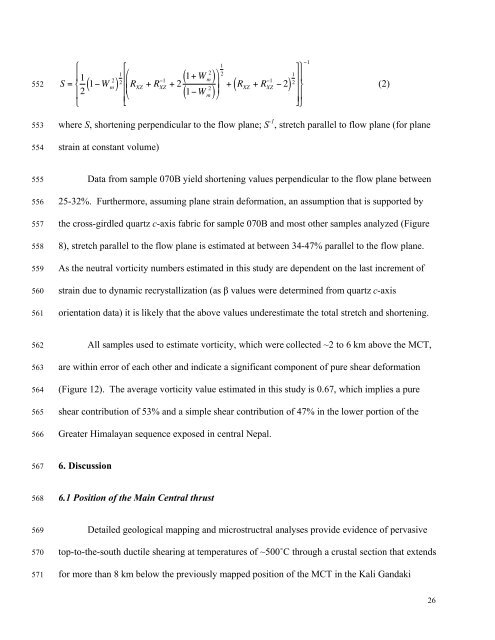Kinematics of the Greater Himalayan sequence, Dhaulagiri Himal ...
Kinematics of the Greater Himalayan sequence, Dhaulagiri Himal ...
Kinematics of the Greater Himalayan sequence, Dhaulagiri Himal ...
Create successful ePaper yourself
Turn your PDF publications into a flip-book with our unique Google optimized e-Paper software.
552<br />
<br />
<br />
S =<br />
1 2 1W 2<br />
<br />
m<br />
<br />
<br />
<br />
<br />
<br />
<br />
<br />
( ) 1 2<br />
<br />
R XZ<br />
+ R XZ<br />
( )<br />
( )<br />
1 + 2 1+ W 2<br />
m<br />
2<br />
1W m<br />
<br />
<br />
<br />
1<br />
2<br />
( ) 1 2<br />
+ R XZ<br />
+ R 1 XZ<br />
2<br />
<br />
<br />
<br />
<br />
<br />
1<br />
(2)<br />
553<br />
554<br />
where S, shortening perpendicular to <strong>the</strong> flow plane; S -1 , stretch parallel to flow plane (for plane<br />
strain at constant volume)<br />
555<br />
556<br />
557<br />
558<br />
559<br />
560<br />
561<br />
Data from sample 070B yield shortening values perpendicular to <strong>the</strong> flow plane between<br />
25-32%. Fur<strong>the</strong>rmore, assuming plane strain deformation, an assumption that is supported by<br />
<strong>the</strong> cross-girdled quartz c-axis fabric for sample 070B and most o<strong>the</strong>r samples analyzed (Figure<br />
8), stretch parallel to <strong>the</strong> flow plane is estimated at between 34-47% parallel to <strong>the</strong> flow plane.<br />
As <strong>the</strong> neutral vorticity numbers estimated in this study are dependent on <strong>the</strong> last increment <strong>of</strong><br />
strain due to dynamic recrystallization (as values were determined from quartz c-axis<br />
orientation data) it is likely that <strong>the</strong> above values underestimate <strong>the</strong> total stretch and shortening.<br />
562<br />
563<br />
564<br />
565<br />
566<br />
All samples used to estimate vorticity, which were collected ~2 to 6 km above <strong>the</strong> MCT,<br />
are within error <strong>of</strong> each o<strong>the</strong>r and indicate a significant component <strong>of</strong> pure shear deformation<br />
(Figure 12). The average vorticity value estimated in this study is 0.67, which implies a pure<br />
shear contribution <strong>of</strong> 53% and a simple shear contribution <strong>of</strong> 47% in <strong>the</strong> lower portion <strong>of</strong> <strong>the</strong><br />
<strong>Greater</strong> <strong><strong>Himal</strong>ayan</strong> <strong>sequence</strong> exposed in central Nepal.<br />
567<br />
6. Discussion<br />
568<br />
6.1 Position <strong>of</strong> <strong>the</strong> Main Central thrust<br />
569<br />
570<br />
571<br />
Detailed geological mapping and microstructral analyses provide evidence <strong>of</strong> pervasive<br />
top-to-<strong>the</strong>-south ductile shearing at temperatures <strong>of</strong> ~500˚C through a crustal section that extends<br />
for more than 8 km below <strong>the</strong> previously mapped position <strong>of</strong> <strong>the</strong> MCT in <strong>the</strong> Kali Gandaki<br />
26

















